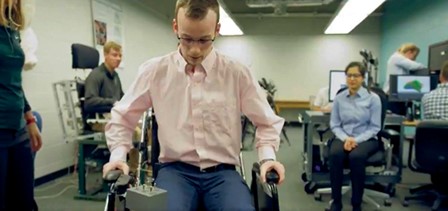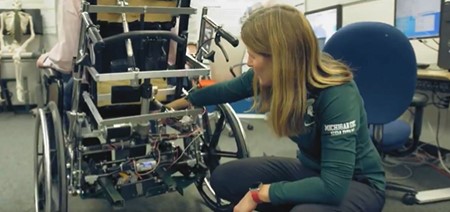Wheelchair Users Find Relief with MSU Professor's Innovation
- Tamara Reid Bush, Ph.D.
- Interim Chair and Professor, Department of Mechanical Engineering
- College of Engineering
Project Overview
- Project investigates wheelchair seat design to alleviate pressure injuries experienced by wheelchair users.
- New seat design automatically alters loading patterns on body, with no extra effort by the user.
Products/Outcomes
- Fewer pressure injuries experienced by wheelchair users
- Currently moving the design toward commercialization through Spartan Innovations
Partners
- Justin Scott, Mechanical Engineering Lab, MSU
- Brian Sheridan, Level 11 Physical Therapy Rehabilitation Center
- Nick Monday, Level 11 Physical Therapy Rehabilitation Center
- Amy Selby, Level 11 Physical Therapy Rehabilitation Center
- Clare Luz, AgeAlive, MSU
- Piotr Pasik, Adaptive Sports and Recreation Club, MSU
Form(s) of Engagement
- Community-Engaged Research
- Community-Engaged Commercialized Activities

Ph.D. student, Garrett Weidig, demonstrates new wheelchair capabilities in Bush's mechanical engineering lab
For individuals who are wheelchair dependent, pressure injuries are common and can be a major deterrent to enjoying a high quality of life. These injuries are typically caused by a constant force being applied to the skin and tissues beneath the skin. In collaboration with individuals affected by these injuries, Tamara Reid Bush, professor and interim chairperson of MSU's Department of Mechanical Engineering, and her research team are using their knowledge of biomechanical design to create a wheelchair to ultimately prevent these life-threatening wounds from ever forming.
Before delving into the redesign of wheelchairs, Bush and her team were first approached by AdientExternal link - opens in new window, formerly Johnson Controls, a leading maker of innovative automotive seating. They were asked to help with researching the development of a new human body manikin that could assist in seat design for automobiles. Specifically, Adient researchers were interested in learning how shear loading, or the slipping forces of a person's legs along a stationary surface, can contribute to tissue tension as well as changes in blood flow.
This automotive work started Bush thinking about the role of shear forces in seating.
Simultaneously, Bush and her team were conducting a second study at Sparrow Hospital's Wound ClinicExternal link - opens in new window in Lansing to study blood flow in the lower leg.
"Many of the community members participating in the clinic suffered from blood clots in their legs and arrived in wheelchairs or using assistive devices," Bush said. "While speaking with the nurses accompanying clinic participants, we began to wonder if the research we were doing on shear loads and body movements in automobile seating could also translate to and benefit individuals using wheelchairs."
Aligning with her long-term goal to apply biomechanics in the medical world, Bush and her team began investigating literature associated with shear loads in wheelchair users. They found theories related to the topic, but limited research, especially as it related to tissue breakdown of the buttocks and thighs.
She and her team used the information they gathered from the automotive seating clinic to springboard a grant proposal to the National Science Foundation (NSF), focusing on the development of a beaded seat design, similar to seat covers being used by taxicab drivers.
"Drivers are sitting on those beads to load and unload pressure, and because the beads are free-rolling, our theory was that the bead motion could relieve tissue tension and reduce shear forces on the tissues," Bush said.
Drawing on what they learned from the original beaded seat design, Bush and her team developed an entirely new seat design. Based on the new design, clinic participants experienced increased blood flow, reduced buttock and lower back pressures, and they were able to alter the loading patterns on the body.
As a follow-up to this work, Bush succeeded in getting a second NSF grant. The Partnership for Innovation (PFI) grant funds technology translation and development based on prior NSF-funded research projects. This would allow Bush and her team to continue their research, and do experimental work on a new wheelchair design, with the original goal of limiting the occurrence of pressure injuries in mind.
Physical Therapy Rehabilitation Center Joins Research, Provides Testing Site

Bush tests design advancements made to prevent pressure injuries in wheelchair users
Enter Brian Sheridan, industrial advisor for Bush's project, as well as owner of Level 11 Physical TherapyExternal link - opens in new window rehabilitation centers. Level 11 provides individuals of all abilities a space to be independent through working with expert clinicians and using up-to-date technology.
Bush and Sheridan's working relationship began in 2009, with Sheridan saying, "We partnered with Dr. Bush and the mechanical engineering department to design and build a body-weight supported gait training system, which is still in use today. Our partnerships have always been very natural and mutually beneficial; the current result is the grant award for the project we're working on now."
Part of the PFI project has involved conducting focus groups to collect feedback and do testing with wheelchair users, therapists, caregivers, physicians, and device suppliers across mid-Michigan. Sheridan was instrumental in making many of these connections, as well as providing a testing space.
"Level 11 has acted as a real-world testing site for research related to the product," Sheridan said. "We've offered therapist support and expert input where needed and provided some of the equipment to assist in testing."
Members of several MSU groups participated in information gathering and testing as well, including AgeAlive and the Adaptive Sports and Recreation Club. The AgeAlive program is dedicated to building a university-wide aging unit to bring people together who are interested in age-related issues. Adaptive Sports and Recreation Club promotes the health, social, and psychological benefits of physical activity to individuals with physical disabilities.
Initial testing of the new prototype involved participants sitting in an array of different positions for a two-hour time period. During that time, pressure and loading on different body regions was examined, as was the blood flow to the buttocks and sacral area. Load cells, which measure force, were used along with a pressure mat to identify pressures on the back and buttocks.
"This is a novel, multi-segmented actuator-driven wheelchair system that is capable of new motions not possible with commercially available wheelchairs," Bush explained. "The new funding from NSF will help us implement the design into a mobile platform that is ready for commercialization. We will also apply automatic adjustments using sensor output when users are in their wheelchairs. That means we can directly address risk factors with pressure injury formation on the thighs, upper, middle and lower back, and buttocks. This design is revolutionary compared to existing wheelchairs as no other chair like this exists."
Commercialization of Innovative Wheelchair in Progress
Following the in-lab testing and several focus groups, the consensus among participants was very similar: We want this chair, and we want it now.
"The wheelchair user may not realize the pressure is being relieved, which is quite remarkable," Sheridan said. "The implications for this product are significant and have the potential to significantly lower the incidence of pressures sores, in a way that requires little to no effort to the person benefiting from the product."
Bush followed-up, saying, "We've talked to many parents who said they have to set alarms to remind their child to reposition in their chairs, or send them to school knowing they may not reposition as often as they should."
The new mobile version of the wheelchair is currently undergoing research and testing with the ultimate goal of commercialization with the help of Spartan Innovations, which provides resources to assist MSU researchers in launching entrepreneurial ventures.
The latest version of the wheelchair can shift positions, loads, and pressures automatically without the user needing to do anything.
"This will be life changing for the parents who may not be able to physically assist their child, a caregiver who's limited in the physical support they can offer, or even an athlete who's no longer able to compete," Sheridan said.
Bush added, "Ultimately, this will impact people's lives in a positive way."
- Written by Emily Springer, University Outreach and Engagement
- Photographs courtesy of the Mechanical Engineering Lab